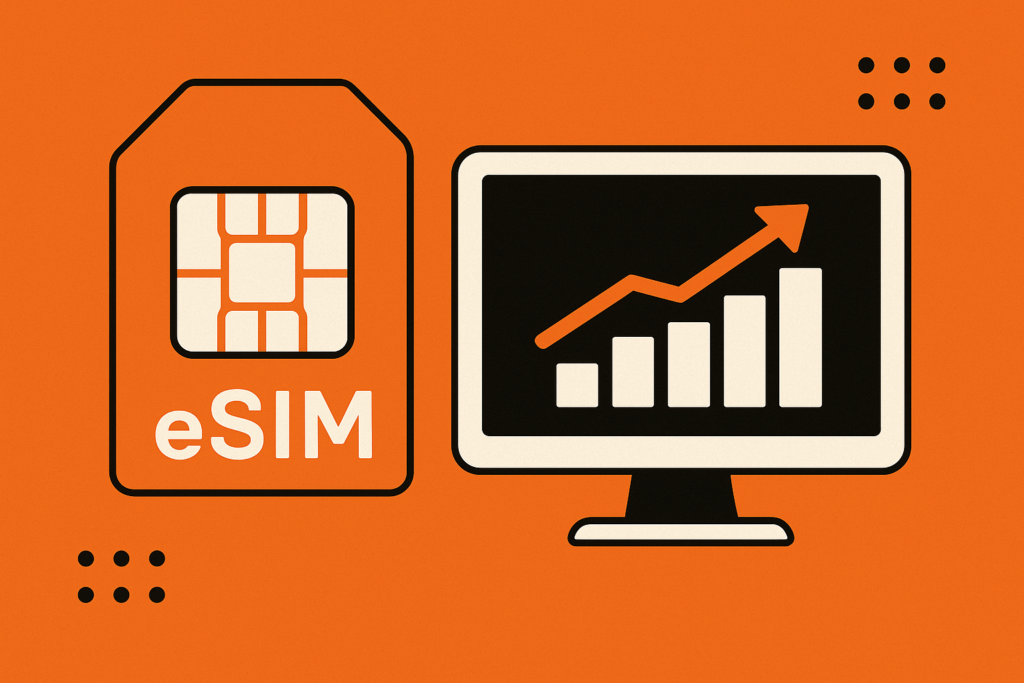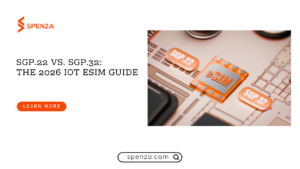TL;DR (For Brands)
- eSIM for enterprises moves from convenience to strategic IT and finance tools in 2025.
- Zero-touch deployment removes global SIM logistics, speeds rollouts.
- Enterprises cut telecom costs by up to 50% through roaming elimination and dynamic carrier selection.
- Corporate mobile management improves with one dashboard for all connectivity.
- IoT connectivity for enterprise scales globally, driving 90% ROI in projects.
- Spenza provides enterprise eSIM management, automation, and global reach with one agreement.
Quick Overview: In 2025, eSIM for enterprises becomes a profit driver. Enterprises reduce telecom costs, improve global device deployment, and scale IoT securely. Zero-touch deployment and enterprise eSIM management make mobility simple. Spenza brings these eSIM business benefits into one global platform.

Beyond a Digital SIM – eSIM is a Strategic Business Tool in 2025
Why do top enterprises in 2025 treat connectivity as a business strategy? Because the debate around eSIM is over. In the early 2020s, it looked like a travel hack. Today, eSIM for enterprises sits at the center of IT, finance, and operations planning.
Analysts estimate nearly 1 billion eSIM smartphone connections by 2025 and the market reaching $16.3 billion by 2027. Trusted Connectivity Alliance notes 503 million eSIMs shipped in 2024, a 35% rise year-on-year. These numbers prove one thing: eSIM business benefits scale globally and drive results.
Enterprises don’t treat eSIM as technology anymore. CIOs and CFOs see it as a P&L lever. The impact is clear. Cut telecom costs, simplify corporate mobile management, and enable global device deployment without friction.
In this blog, we explore the three enablers driving adoption of eSIM for enterprises today. Then we show how Spenza’s enterprise eSIM management platform connects strategy to execution.
What Would You Get by the End of the Article?
- Why eSIM for enterprises changes the economics of connectivity.
- How zero-touch deployment enables global device deployment at scale.
- Where telecom savings appear and how finance teams measure them.
- How IoT connectivity for enterprise scales to billions of devices.
- Why enterprise eSIM management makes mobility predictable.
- How Spenza delivers these benefits with one global contract.
Why eSIM for Enterprises is a Business Enabler
The market no longer asks what eSIM is. The real question is how to use it. Enterprises deploy it to reach business goals: faster rollouts, predictable costs, and IoT growth.
Let’s break down the three big enablers.

Enabler #1: The End of Logistics – Streamlined Global Device Deployment
Enterprises struggled to deploy 5,000+ laptops, tablets, or IoT devices across borders. Each market needed separate SIM cards. Shipping delays, customs checks, and dozens of carrier contracts turned global device deployment into a nightmare. IT teams spent weeks on SIM provisioning.
The eSIM-Enabled Way (The Solution)
Zero-Touch Deployment
With eSIM, devices ship straight from the factory to the end user. On first power-up, the device downloads a pre-configured profile through enterprise eSIM management. IT never touches a SIM card. This zero-touch deployment model removes weeks of manual effort. Spenza explains how one SKU works worldwide, removing SIM stock handling.
Centralized Global Control
From one dashboard, an admin in Texas can provision devices in Tokyo or Berlin instantly. This is true corporate mobile management at global scale. Devices switch profiles remotely. Enterprises reduce inventory and IT load while keeping everything secure.
The Business Outcome
- Faster productivity: Employees get connected the moment devices arrive.
- Lower IT costs: Deploying an eSIM costs only 20% of physical SIM deployment.
- Simplified supply chain: One global SKU replaces multiple SKUs.
- Predictable rollouts: Remote provisioning reduces project timelines by weeks.
Real example: Logistics firms use remote provisioning to switch trackers across borders. IoT Analytics reports this cuts delays and ensures devices always connect to local carriers at local rates.
For enterprises, this means global device deployment becomes simple, scalable, and fast.
Enabler #2: From Cost Center to Cost Control – Radical Telecom Expense Reduction
Corporate telecom used to drain budgets. Business travelers paid thousands in roaming fees. Companies locked into one expensive carrier lost flexibility. Finance teams lacked visibility into usage.
The eSIM-Enabled Way (The Solution)
Eliminate Roaming Fees
Devices switch to local profiles at local prices when entering new countries. No roaming. No surprise bills. Enterprises adopting eSIM report 30–50% savings on roaming spend.
Dynamic Carrier Optimization
With enterprise eSIM management, IT assigns multiple carrier profiles to devices. Each connects to the lowest-cost option. This breaks single-carrier lock-in. CFOs see direct impact on telecom line items.
Pooled Data & Real-Time Visibility
Instead of isolated plans, companies pool global data. They see consumption live, enforce policies, and stop overages. Dashboards create transparency for finance and IT. Spenza’s analytics show which teams use the most data so policies adjust instantly.
The Business Outcome
- Lower spend: Up to 50% cost reduction.
- Predictable bills: One invoice instead of dozens.
- Policy enforcement: Real-time usage visibility.
- Lower admin load: Finance saves 30% time on billing reconciliation.
Real case: A US enterprise cut nearly half its telecom bills in one year by switching to eSIM pooling and dynamic optimization. CFOs call this eSIM business benefits in numbers, not theory.
Enabler #3: Driving Agility – Unlocking New Connected Use Cases
IoT or temporary connectivity was slow, costly, and complex. SIM logistics delayed projects. Enterprises avoided testing new ideas because connectivity costs made pilots risky.
The eSIM-Enabled Way (The Solution)
Reliable Backup Connectivity (Failover)
With eSIM, devices run multiple carrier profiles. If one fails, another activates. Branches, retail stores, or IoT gateways stay online. Downtime can cost $2,000 to $100,000 per hour. Failover avoids that loss.
Flexible Connectivity for Temporary Sites
Construction teams, events, and pop-up stores need fast networks. With eSIM routers, IT provisions instantly. After the event, it deactivates the profile. This is cost control in action. Spenza explains how profiles scale up or down with ease.
Scalable IoT Deployment
IoT connectivity for enterprise grows fast. By 2030, nearly 40 billion devices connect globally. Over 90% of companies report positive ROI on IoT. eSIM makes it scalable with instant provisioning. Enterprises activate thousands of devices in minutes instead of months.
The Business Outcome
- Agility: IT launches projects faster.
- Resilience: Failover keeps critical systems live.
- Innovation: IoT tests scale into new revenue models.
Case: Event organizers in the US run ticketing, POS, and live streaming on eSIM-enabled routers. Without fast provisioning, this would be impossible.
With eSIM, enterprises move from slow to agile in their connectivity strategy.
Spenza: The Enterprise Platform to Activate Your eSIM Strategy
The first half of this guide explained why eSIM for enterprises is no longer optional. Enterprises want cost savings, faster global device deployment, and new IoT connectivity for the enterprise. But the real question is how to make it happen at scale. That’s where Spenza comes in.

Enterprise-Grade Security & Management
Enterprises need more than a consumer eSIM app. They need enterprise eSIM management that connects thousands of devices securely. With Spenza, IT admins use one dashboard to manage every SIM profile across 190+ countries.
This means:
- Role-based access for IT teams.
- Policy enforcement for data usage.
- Security tools like remote SIM lock and instant deactivation.
- Analytics that show cost per device in real time.
See Spenza’s enterprise eSIM platform for details on how one system connects device activation, billing, and security in a single view.
A Single Global Network Agreement
Procurement teams hate carrier lock-in. They also hate managing 30+ local contracts. Spenza fixes this with one global agreement. Enterprises sign one contract and instantly access 190+ carriers worldwide.
That’s less time negotiating contracts, fewer legal reviews, and no more carrier-by-carrier headaches. With Spenza global connectivity, businesses get coverage in every region with one SLA and one invoice.
This shifts corporate mobile management from fragmented to centralized. Finance teams finally see a clear view of telecom spend, with predictable billing across all countries.
Seamless API Integration
Spenza is API-first and cloud-native. That means enterprises don’t rip and replace their IT systems. Instead, Spenza integrates into what they already use.
- MDM systems: auto-assign profiles when a device enrolls.
- ITSM tools: auto-open or close tickets for provisioning.
- ERP and finance systems: auto-feed usage and billing data.
With this automation, zero-touch deployment becomes reality. Devices can be shipped to employees anywhere and profiles pushed automatically. This ties directly into Spenza’s IoT eSIM introduction, which explains how automation supports massive IoT scale.
Customization and Scalability
Spenza isn’t just about cost savings. It also lets enterprises launch new models. For example, some brands use Spenza to create eSIM-only programs for customers or devices. This is possible because Spenza functions as a modern MVNE. It combines billing, usage analytics, and SIM provisioning in one platform.
This opens doors for enterprises to experiment. They can monetize devices, offer new digital services, or create internal cost-sharing models. See Spenza’s eSIM-only MVNOs 2025 article for how this works in practice.
Conclusion: In 2025, Your Connectivity Strategy IS Your Business Strategy
By 2025, eSIM for enterprises has matured into core business infrastructure. It is not about convenience. It is about cost, speed, and resilience.
- Cost: Companies cut roaming fees by 30–50%, pool data, and enforce usage policies.
- Speed: Zero-touch deployment enables global device deployment in days, not months.
- Resilience: Backup connectivity keeps systems live, avoiding losses of $2,000 to $100,000 per hour during outages.
Enterprises that invest in enterprise eSIM management now are ahead. They run operations faster. They keep telecom costs predictable. They explore IoT connectivity for enterprise without barriers. And they move connectivity from a hidden cost to a business enabler.
Spenza is the platform that makes this real. With one global contract, one dashboard, and full automation, it simplifies how enterprises run connectivity. It is more than telecom—it is business execution.
FAQs
Finance teams finally see transparent billing. They eliminate unpredictable roaming charges, pool global data, and handle one invoice instead of dozens. Predictability means better budget control for CFOs.
Instead of shipping SIMs, devices ship directly to employees. On power-up, they download corporate profiles. This zero-touch deployment means no delays at customs, no SIM swaps, and instant connectivity worldwide.
Yes. Spenza is API-first. It integrates with MDM, ITSM, ERP, and finance platforms. This automation makes zero-touch deployment possible and creates full visibility for IT and finance.
Spenza gives one global contract, 190+ carriers, and enterprise eSIM management in one platform. It supports both internal mobility and IoT growth. Enterprises move faster with Spenza because they cut costs, simplify IT, and scale globally.
So the question for CIOs, CTOs, and CFOs is simple: Are you ready to treat connectivity as a business strategy? If yes, contact Spenza today for a personalized consultation.






